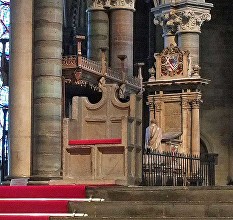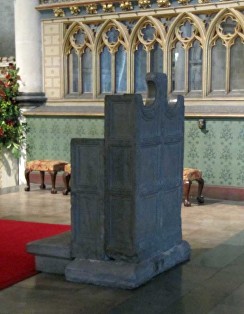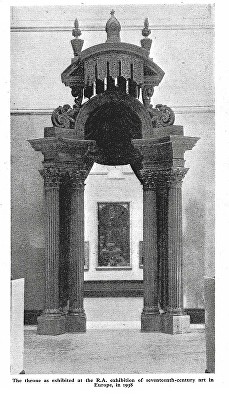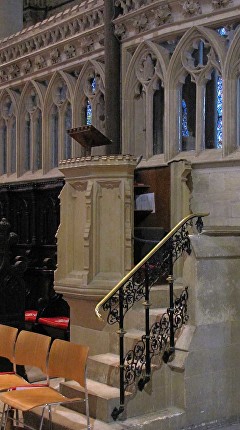CANTERBURY HISTORICAL
& ARCHAEOLOGICAL SOCIETY (CHAS)
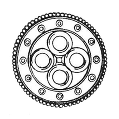








The Choir and Trinity Chapel
The Archbishop’s Seats
In recent years the archbishop has been enthroned on two seats. The diocesan throne comes first in the procedure; a Victorian stone seat located in the choir, when the archbishop becomes Bishop of the See of Canterbury. This ceremony is then followed by occupation of the medieval marble Chair of St Augustine representing the Archbishop’s installation as Primate of All England.
The Marble Chair
It is thought that the fire of 1174 in all likelihood destroyed the Patriarchal chair that once stood towards the east end of the cathedral. The conflagration necessitated the need to build a new chair, and naturally one fitting for ceremonial use; a chair of marble was decided upon. The chair today situated centrally in the Trinity Chapel at the top of the steps has been known as the Chair of St Augustine, although this title is something of a misnomer, as it postdates the first archbishop by some 600 years. The date of construction of the marble chair, based on payment records, has been placed between 1201 and 1204. The chair has therefore been used for enthronements at Canterbury since the 13th century with Archbishop Stephen Langton probably the first archbishop to ceremonially occupy the chair. The chair would have been available for use during the Translation of Saint Thomas Becket from the crypt to his newly built shrine in the Trinity Chapel on 7th July 1220.
The chair and base comprise five pieces of Purbeck Marble, the limited height of the stone bed probably not permitting a single stone construction. The stone has been carved with deep panels throughout. A reference in the accounts to the first payment made to a carpentarius suggests the construction of a wooden model upon which the stone chair was based.
In 1825 the extraordinary decision was taken to move the marble chair from its central position to the South East Transept; the chair was later to return to some prominence when moved to the Corona. Here it remained until 1977 when it was considered that the chair should be returned to its original prominent position at the top of the steps to the Trinity Chapel facing west. It is said to be the only surviving marble chair in the country dating back to the Middle Ages.
The Stone Chair
In 1704 Archbishop Tenison had paid for a new wooden archbishop’s throne. The throne was made from oak and carved by Grinling Gibbons possibly from a design of Nicholas Hawksmoor. In 1844 this wooden throne was dismantled and removed to storage. Hansard records that in 1890 the question of the care of Tenison’s throne was raised in Parliament when it was described as having been “for many years past stowed away as lumber in a damp cellar adjacent to the cathedral cloisters”.
It was Archbishop Howley who funded a replacement chair to be constructed of stone, perhaps in the hope that enthronements in persona would recommence following his tenure. It has been suggested by Lawrence and Marjorie Lyle that “he [Howley] may have hoped that a grand archiepiscopal throne would help to restore a real, rather than a proxy, enthronement of his successor for the first time since the reign of Queen Anne in 1708.” Hooley arranged for George Austin (Senior), the cathedral’s first appointed Surveyor, to design a new stone throne. The construction took just over twelve months. A delightful sketch by Austin of the new throne still exists in the Cathedral Archives bearing his initials. The throne was set on steps beside the choir screen entrance adjacent to the South East Transept. Its soaring canopy exemplifies the gothic aesthetic that existed at the time.
The Builder Magazine for November 1848 states, “The new throne ... was the last addition to this cathedral by Mr. Austin. The design is in character with that of the altar screen, and also with a design for the erection of stone stalls ... The ornamental parts were prepared by [Flemish] workmen who had been employed in the cathedrals of Brussels and Cologne, as Englishmen could not be obtained at the moment. It was erected at a cost of about 1,200l., which was defrayed by the last archbishop [Howley], whose armorial bearings ornament the interior of the throne. It has been proposed to paint and gild some portions of the throne and altar screen, but we are not anxious that this should be done.” The painting and gilding was not to take place.
In Woodruff and Danks Memorials of the Cathedral & Priory of Christ in Canterbury the authors describe Howley’s new throne as made from “bathstone” (Bath Stone). The expense account for the throne is still extant and would suggest a different stone was purchased. In the account book are recorded payments between 25th November 1843 and 10th December 1844 totalling £1094 18s 11d. An early entry records “Expenses for going to Town [London] to purchase Caen Stone for the work.” During 1843 Caen Stone was also being used in the construction of the Houses of Parliament and was therefore potentially available for purchase in the capital. However, the appearance of the stone used for the throne’s construction is more consistent with that of a variety of Bath Stone. The stepped plinth on which the throne rests is probably made from the same stone; unfortunately the individual floor stones are much worn in places and too badly scratched throughout to aid a positive identification. The two dark stone steps on the west side beneath the throne’s entrance door are of Purbeck Marble and, in view of their excellent condition, are likely to be modern replacements. The top step contains fossils of the freshwater bivalve Unio while the small snail shells can best be seen on the side of each step.
The stone throne was first used for the inauguration of Archbishop John Bird Sumner in 1848 which heralded the introduction of the modern Enthronement Service.
The Choir Pulpit
Shortly after his appointment as Dean in 1845, William Lyall sought to construct a new choir pulpit, which in the words of The Ecclesiologist (Volume 8, page 57) would replace “the miserable one which was formerly used”. Lyall turned to the up-and-coming young architect William Butterfield who at the time was in Canterbury designing a new missionary college at St Augustine’s and later restoring St. Nicholas' Church, Thanington.
The stone pulpit, the gift of Dean Lyall, was constructed and positioned in 1847 (or 1846, dates in sources vary) on the north wall of the choir at the east end of the south-facing choir stalls. It is built of Caen Stone and lined internally with wood. There are five external inset panels separated by stepped and projecting buttress-like dividers. The whole is modest in design and consequently often overlooked.
Memorial and Fittings stones in the choir
 HOME
CONTACT US
MAIN SITE
HOME
CONTACT US
MAIN SITE
© Geoff Downer 2019

